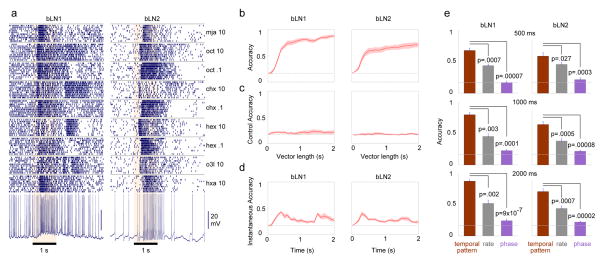Figure 3.
Response patterns in bLNs contain information about odor identity. (a) Dense, temporally patterned, and odor-specific responses of representative bLN1 and bLN2 neurons to 0.1% or 10% concentrations of various odors. Note reproducible patterns across 10 trials with each odor. (b) Classification accuracy of many bLNs to a set of 6 odors (0.1% and 10% concentrations of hex, chx and oct) exceeded chance (dashed line: 1/6); n = 6 bLN1s, 9 bLN2s. Solid line with shading: mean (across bLNs) with s.e.m. (c) Classification accuracy using bLN activity 2 s before odor delivery is at chance level. This control analysis shows that the above-chance performance observed in panel b depends on odor-evoked response patterns, and is not due to differences in background firing. (d) A modified classification analysis using short instantaneous segments of responses (see Experimental Procedures) shows performance above chance throughout the 2 s period. (e). Although bLN spikes were phase-locked to 20 Hz LFP oscillations (for both bLN1 and bLN2), the average phase or the average firing rate of spikes performed poorly, compared to the temporal patterns of spikes, on classifying odor identity (bLN1: n=6; bLN2: n=9); error bars: s.e.m. The same result was obtained whether we analyzed responses in intervals of duration 500 ms, 1000 ms or 2000 ms after the onset of odor. See also Fig. S4.

